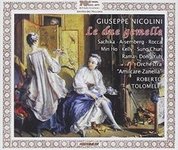|
Back
10/03/2014
Giuseppe Nicolini: Le due gemelle
Ito Sachika (Giannina), Aloisa Aisemberg (Giulia), Lee Min Ho (Monsieur Le Blau), Ciaran Kelly (Conte Arrigo di Terra Fosca), Davide Rocca (Marchese Tramontana), Kim Sung Chun (Monsieur Bombetta), Mimoza Rama (Giacometta), Lee Dong Yub (Timpano), Orchestra “Amilcare Zanella”, Roberto Tolomelli (Conductor)
Live recording: Teatro Municipale di Piacenza (April 28, 2012) – 92’36
Bongiovanni # GB 2467-2 & GB 2468-2 (2 CDs) – Booklet in Italian and English

   
Giuseppe Nicolini can be partially credited for helping pave way from the Classical Age into early 19th century Italianate music. Stylistically, Nicolini followed in the footsteps of Paisiello’s and Cimarosa’s more mature works. Le due gemelle is a good example of Nicolini’s middle year compositions that foreshadow Gioachino Rossini. Despite melodic pleasantries, the Nicolini one-act opera is rudimentary, shallow and lacking the elaborate sophistication that Rossini would move on to perfect and progressively innovate.
Harpsichord is the predominant instrument within gemelle, and immediately we are reminded of similarities to Mozart’s many works (i.e. Don Giovanni, Così) in terms of structural underpinnings such as secco recitativo. With a cursory glance at the liner notes, one will see a musical "balance sheet", a Nicolini placement that precisely alternates between recitativo and set musical numbers, whether it be a duet, trio, quartet or cavatina.
One of the more choice pieces inside Le due gemelle is the aria “Vieni, o caro canarino” with its entrance aria for the silly twin, Giulia, that's amply sung by Aloisa Aisemberg: the soprano voice carries substantially, is wholesome, yet prickly at times. Another highlight is Le Blau’s cavatina, “En secret mon cœur mi dice” (originally eliminated in the manuscripts with easy reinstatement), sung by Lee Min Ho, who has sufficiently measured timbre and pleasant softness which facilitates in adding a degree of masculine warmth. This dramma giacoso lives up to its reputation as the ensuing dialogue jumps out with shrieks and screams, conjuring images of Rosina from Il barbiere. This is an important reminder since Le due gemelle premiered in 1811 in comparison to Rossini’s Il barbiere in 1818.
Ciaran Kelly’s Count Arrigo weaves into Aisemberg’s notes. Even though the music is finely portrayed, the passion and amorous intensity doesn’t convince: lovely harmonies, shallow in emotional depth.
Amongst the love entanglements vacillating between twins Giannina and Giulia, Monsieur Le Blau and Count Arrigo, there exists a second underlying story involving the servants of the Marchese Tramontana, Giacometta and Timpano. Lee Dong Yub’s Timpano pleases with nicely rounded notes and legatos while his approaches toward Giacometta are resolutely requisitioned by Mimoza Rama in her aria, “Vuo’ che il core.” Her vocalization has attenuated silkiness, yet the vibrato remains irritatingly wobbly. Ito Sachika, whose character, Giannina (the other twin), has been downgraded to becoming a servant, possesses the loveliest relating to a radiant voice with clean and polished lines. There’s a close resemblance to the melodic fluidity found inside that of coloratura Sumi Jo.
Perhaps due to Roberto Tolomelli’s languid tempo, Le due gemelle, however, doesn’t contain measurable spark or animation. Several attempts are made to enliven, but it is pallid. The recording, live from Piacenza, has bothersome background rumbling. Maybe the bumbling culprit is a nervous prompter or a character on stage, but on surface it is annoyingly disconcerting. Liner notes are sparse, but at least a full libretto is made available.
Christie Grimstad
|